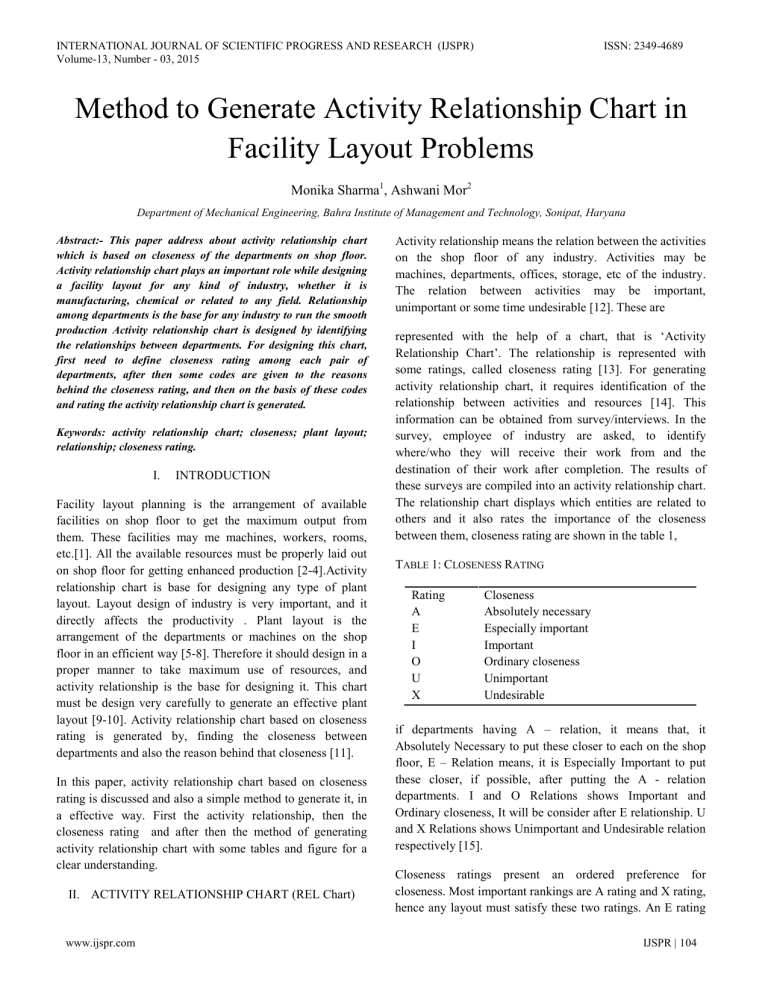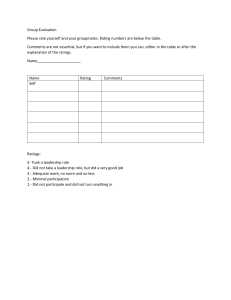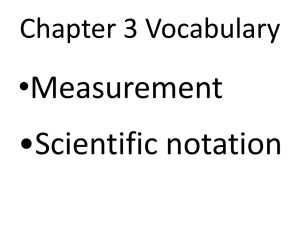
INTERNATIONAL JOURNAL OF SCIENTIFIC PROGRESS AND RESEARCH (IJSPR) Volume-13, Number - 03, 2015 ISSN: 2349-4689 Method to Generate Activity Relationship Chart in Facility Layout Problems Monika Sharma1, Ashwani Mor2 Department of Mechanical Engineering, Bahra Institute of Management and Technology, Sonipat, Haryana Abstract:- This paper address about activity relationship chart which is based on closeness of the departments on shop floor. Activity relationship chart plays an important role while designing a facility layout for any kind of industry, whether it is manufacturing, chemical or related to any field. Relationship among departments is the base for any industry to run the smooth production Activity relationship chart is designed by identifying the relationships between departments. For designing this chart, first need to define closeness rating among each pair of departments, after then some codes are given to the reasons behind the closeness rating, and then on the basis of these codes and rating the activity relationship chart is generated. Keywords: activity relationship chart; closeness; plant layout; relationship; closeness rating. I. INTRODUCTION Facility layout planning is the arrangement of available facilities on shop floor to get the maximum output from them. These facilities may me machines, workers, rooms, etc.[1]. All the available resources must be properly laid out on shop floor for getting enhanced production [2-4].Activity relationship chart is base for designing any type of plant layout. Layout design of industry is very important, and it directly affects the productivity . Plant layout is the arrangement of the departments or machines on the shop floor in an efficient way [5-8]. Therefore it should design in a proper manner to take maximum use of resources, and activity relationship is the base for designing it. This chart must be design very carefully to generate an effective plant layout [9-10]. Activity relationship chart based on closeness rating is generated by, finding the closeness between departments and also the reason behind that closeness [11]. In this paper, activity relationship chart based on closeness rating is discussed and also a simple method to generate it, in a effective way. First the activity relationship, then the closeness rating and after then the method of generating activity relationship chart with some tables and figure for a clear understanding. II. ACTIVITY RELATIONSHIP CHART (REL Chart) www.ijspr.com Activity relationship means the relation between the activities on the shop floor of any industry. Activities may be machines, departments, offices, storage, etc of the industry. The relation between activities may be important, unimportant or some time undesirable [12]. These are represented with the help of a chart, that is ‘Activity Relationship Chart’. The relationship is represented with some ratings, called closeness rating [13]. For generating activity relationship chart, it requires identification of the relationship between activities and resources [14]. This information can be obtained from survey/interviews. In the survey, employee of industry are asked, to identify where/who they will receive their work from and the destination of their work after completion. The results of these surveys are compiled into an activity relationship chart. The relationship chart displays which entities are related to others and it also rates the importance of the closeness between them, closeness rating are shown in the table 1, TABLE 1: CLOSENESS RATING Rating A E I O U X Closeness Absolutely necessary Especially important Important Ordinary closeness Unimportant Undesirable if departments having A – relation, it means that, it Absolutely Necessary to put these closer to each on the shop floor, E – Relation means, it is Especially Important to put these closer, if possible, after putting the A - relation departments. I and O Relations shows Important and Ordinary closeness, It will be consider after E relationship. U and X Relations shows Unimportant and Undesirable relation respectively [15]. Closeness ratings present an ordered preference for closeness. Most important rankings are A rating and X rating, hence any layout must satisfy these two ratings. An E rating IJSPR | 104 INTERNATIONAL JOURNAL OF SCIENTIFIC PROGRESS AND RESEARCH (IJSPR) Volume-13, Number - 03, 2015 is second ranked, and most, if not all, E rating should be satisfied by the layout, an I rating is third ranked, and as many as possible should be satisfied, without sacrificing A, E, or X ratings. In the same way, O ratings are fourth ranked and they should be satisfied after A, E, X or I ratings. U ratings can be ignored while designing the layout. Thus, A and X > E > I > O > U, where > means “more important or higher ranking than” [16]. 3. 4. 5. ISSN: 2349-4689 Define the criteria for assigning closeness relationship and record the criteria as the reasons for the relationship values on the chart. Establish the relationship value and the reasons for the values for all pairs of departments. Allow everyone having input to the development of the relationship chart an opportunity to evaluate and discuss changes in the chart. Figure 1 shows description and figure 2 shows a example of REL Chart. Rule of thumb: Very few A and X relationships should be assigned. (no more than 5% of the closeness ratings to be an A and X). No more than 10% should be an E. No more than 15% to be an I. No more than 20% to be an O. Which means that about 50% of the relationships should be U. There is always reason behind the closeness rating between activities. It may be any reason, like flow of materials, contact necessary, etc. some such reasons are shown in table 2. This Showing 1 1 2 Importance R l ti hi 3 2 Block Relation of 4 Reasons C d (B l in ) 3 Figure 1: Activity Relationship Chart Description TABLE 2: REASONS BEHIND THE CLOSENESS RATING Code Reasons 1 Flow of material 2 Ease of supervision 3 Common personal 4 Contact necessary 5 Noise and disturbance 6 Similar type of equipments III. METHOD TO CONSTRUCT ACTIVITY RELATIONSHIP CHART A relationship chat may be constructed as follow: 1. 2. List all departments on the relationship chart. Conduct interviews or surveys with persons from each departments listed on the relationship chart and also with the management responsible for all departments. www.ijspr.com Figure 2: Activity Relationship Chart IV. CONCLUSIONS In this paper author discusses about Activity Relationship Chart based on closeness rating and also about a simple method of constructing the chart. This chart is very important tool for designing a layout for any type of industry, so it must be consider very carefully while designing the layout. Role of IJSPR | 105 INTERNATIONAL JOURNAL OF SCIENTIFIC PROGRESS AND RESEARCH (IJSPR) Volume-13, Number - 03, 2015 thumb for closeness rating also helps to generate the ratings between departments. This relationship chart can be constructed for any type of industry. The method will be same for constructing this chart. Every industrial engineer must know about the method to generate this chart. V. REFERENCES [1] P. Sharma, and S. Singhal, ‘A review of objectives and solution approaches for facility layout problems’, Int. J. Industrial and Systems Engineering, In Press, 2015 [2] Rathi, R., Khanduja, D. and Sharma, S. ‘Synergy of fuzzy AHP and Six Sigma for capacity waste management in Indian automotive industry’, Decision Science Letters, Vol. 4, No. 3, pp.441–452. 2015a [3] Rathi, R., Khanduja, D. and Sharma, S. ‘Six Sigma project selection using fuzzy TOPSIS decision making approach’, Management Science Letters, Vol. 5, No. 5, pp.447–456. 2015b [4] P. Sharma, and S. Singhal, ‘Comparative analysis of procedural approaches for facility layout design using AHP approach’, Int. J. Manufacturing Technology and Management. In Press, 2015 [5] Sharma, P., Phanden, R. K., and Baser, V. Analysis of site selection based on factors rating. International Journal of Emerging trends in Engineering and Development, 6(2), 616622. 2012. [6] Sharma, P., Singh, R. P., & Singhal, S. A Review of Metaheuristic Approaches to Solve Facility Layout Problem. 2013 [7] Sharma, P., Phanden, R. K., & Singhal, S. A Comparative Analysis of Facility Layout Design and Optimization Techniques. 2013 [8] Singh, R., Singhal, S., & Sharma, P. Application of AHP in the Analysis of Cellular Manufacturing System. 2015 [9] K. B. Zandin, “Maynard’s Industrial Engineering Handbook”, McGraw-Hill Standard Handbooks, 5th Edition, 2004, pp. 1201 – 1215. ISSN: 2349-4689 [12] S. P. Singh, “Solving Facility Layout Problem: Three Level Tabu Search Metaheuristic Approach”, International Journal of Recent Trends in Engineering, 2009, pp. 73 – 77. [13] J. A. Tompkins, and J. A. White, “Facilities Planning”, Wiliey, New York, 2010. [14] S. Benjaafar and M. Sheikhzadeh, “Design of Flexible Layouts for Manufacturing Systems”, International Conference on Robotics and Automation, Minneapolis, Minnesota, 2008, pp. 852 – 857. [15] I. Grassie, “Facility Planning: An Approach To Optimize A Distribution Network at Clover SA”, University of Pretoria, October 2009. [16] K. B. Zandin, “Maynard’s Industrial Engineering Handbook”, McGraw-Hill Standard Handbooks, 3th Edition. [10] “Guidelines for Facility Sitting and Layout”, Center for Chemical Process Safety of the American Institute of Chemical Engineers. 2003, pp. 8 – 11. [11] R. Jayachitra and P. S. Prasad, “Design and Selection of Facility Layout Using Simulation and Design of Experiments”, Indian Journal of Science and Technology, 2010, pp. 437 – 446. www.ijspr.com IJSPR | 106


